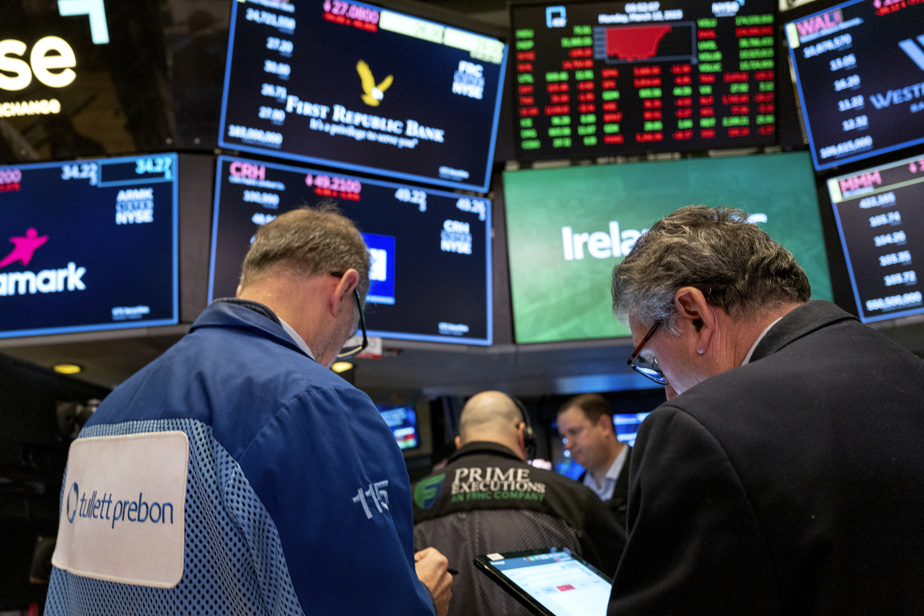(New York) The New York Stock Exchange ended narrowly in negative territory on Friday after mixed activity indicators in the United States should not deter the Fed from raising interest rates again in early May.
The Dow Jones index fell 0.42% to 33,886.47 points, the tech-heavy NASDAQ lost 0.35% to 12,123.47 points and the S&P 500 fell 0.21% to 4137. .64 points.
However, the blue chip index posted its fourth positive week in a row.
Several major US banks on Friday unveiled comfortable results for the first quarter thanks in particular to the rise in interest rates, seeming to have avoided the contagion of the turmoil that shook regional banks in early March.
The banking sector was one of the few to conclude in the green (+0.96%) on Wall Street.
At the same time, several activity indicators published Friday in the United States have cooled investors, including retail sales in March which fell by 1%, more than expected.
“Retail sales were weak and disappointing,” largely due to lower gasoline costs but also a decline in auto sales, said Chris Low of FHN Financial.
Another index showed mixed activity last month, that of industrial production.
This rose to +0.4%, more than expected, but it was only because of the demand for heating which boosted the production index for public services, while that for manufacturing production fell by 0.5%.
Finally, the University of Michigan published its first estimate of US consumer confidence for April.
While this improved to 63.5 points (+2.4%), consumer expectations for the evolution of inflation, on the other hand, worsened. They now see price increases reaching 4.6% this year when they hoped for 3.6% last month.
Despite these negative signs, one of the governors of the Federal Reserve (Fed), Christopher Waller, argued vigorously for one or more additional interest rate hikes.
“The labor market remains strong and quite tight, and inflation is well above target, so monetary policy needs to be tightened further,” Waller said.
In the bond market, yields on two-year Treasury bonds rose above 4% to 4.09% at 4:30 p.m. (Eastern Time) from 3.96% the day before. Those at ten years climbed to 3.51% against 3.44% on Thursday.
As for banking results, JPMorgan Chase soared (+7.55% to 138.73 dollars) after announcing for the first quarter an increase in its net profit on record turnover, thanks to rates more remunerative interest.
Citigroup rose 4.78% after reporting better-than-expected first-quarter results, also benefiting from higher interest rates.
Goldman Sachs was driven higher (+1.44%).
Health insurance group United Health saw its stock fall 2.74% despite an increase in revenue and net earnings per share in the first quarter. Another insurance group, Travelers, also lost 2.79%.
The big names in techno have had mixed fortunes, Microsoft yielding 1.28% while Alphabet (Google) advanced by 1.17%.
Elsewhere on the stock exchange, the aircraft manufacturer Boeing slowed down the Dow Jones, dropping 5.56% to 201.71 dollars.
The aircraft manufacturer warned Thursday that deliveries of its flagship aircraft, the medium-haul 737 MAX, would be temporarily disrupted for quality problems on parts supplied by Spirit Aerosystems. The stock of this supplier fell more than 20%.
Toronto Stock Exchange
The Toronto Stock Exchange posted a slight gain on Friday, led by the battery metals sector, as major U.S. indices closed lower, despite the release of better-than-expected quarterly results from some of the largest banks in the States. -United.
All eyes were on the banks on Friday when they released their financial results for the first quarter of the year, said Angelo Kourkafas, investment strategist for the firm Edward Jones.
“The banks have opened the earnings season,” he said. And it was better than expected. »
That gave some support to the market, although it contracted slightly on the heels of Thursday’s rally, he observed.
The Toronto Stock Exchange’s S&P/TSX Composite Index gained 15.42 points to end the day with 20,579.91 points.
The results of the banks are encouraging, argued Mr. Kourkafas.
“Today, JP Morgan, Citibank, Wells Fargo and PNC all exceeded expectations,” he said.
He noted that expectations for bank earnings have been scaled back since last month’s banking crisis.
Retail sales in the United States slowed in March, another sign of the economy weakening under the pressure of high interest rates, while Canadian manufacturing sales were also slightly weaker.
Separately, senior Federal Reserve official Christopher Waller said Friday that further interest rate hikes were needed to bring inflation under control.
According to Kourkafas, the consensus in favor of an interest rate hike in the Fed’s decision due in June has strengthened after these comments.
Some of the rate cuts markets seem to be taking for granted in Canada and the United States will need to be recalibrated, he warned.
“Bond yields are a bit higher as positive economic momentum likely means the central bank’s job is not done. »
Next week, Canada will release retail sales data and new inflation figures, while in the United States the focus will shift more to quarterly corporate results, Kourkafas said.
Investors will be primarily interested in company forecasts for the coming quarters.
In the currency market, the Canadian dollar traded at an average rate of 74.84 cents US, down from 74.86 cents US on Thursday.
On the New York Commodities Exchange, crude oil rose 36 cents to US$82.52 a barrel, while natural gas rose 11 cents to US$2.11 a million. BTUs.
The price of gold plunged US$39.50 to US$2015.80 an ounce and that of copper depreciated 2 cents US to US$4.11 a pound.
The Canadian Press
